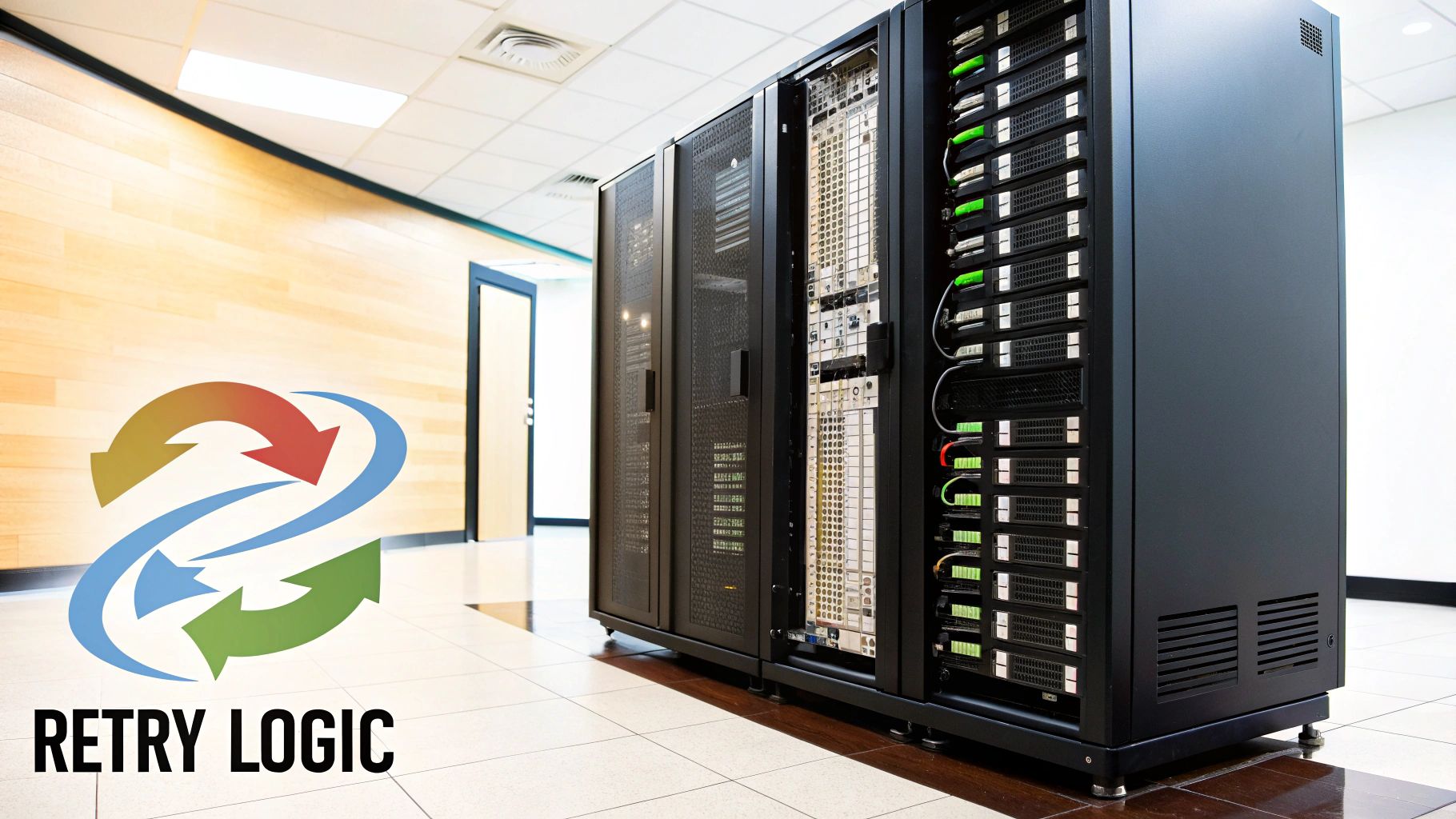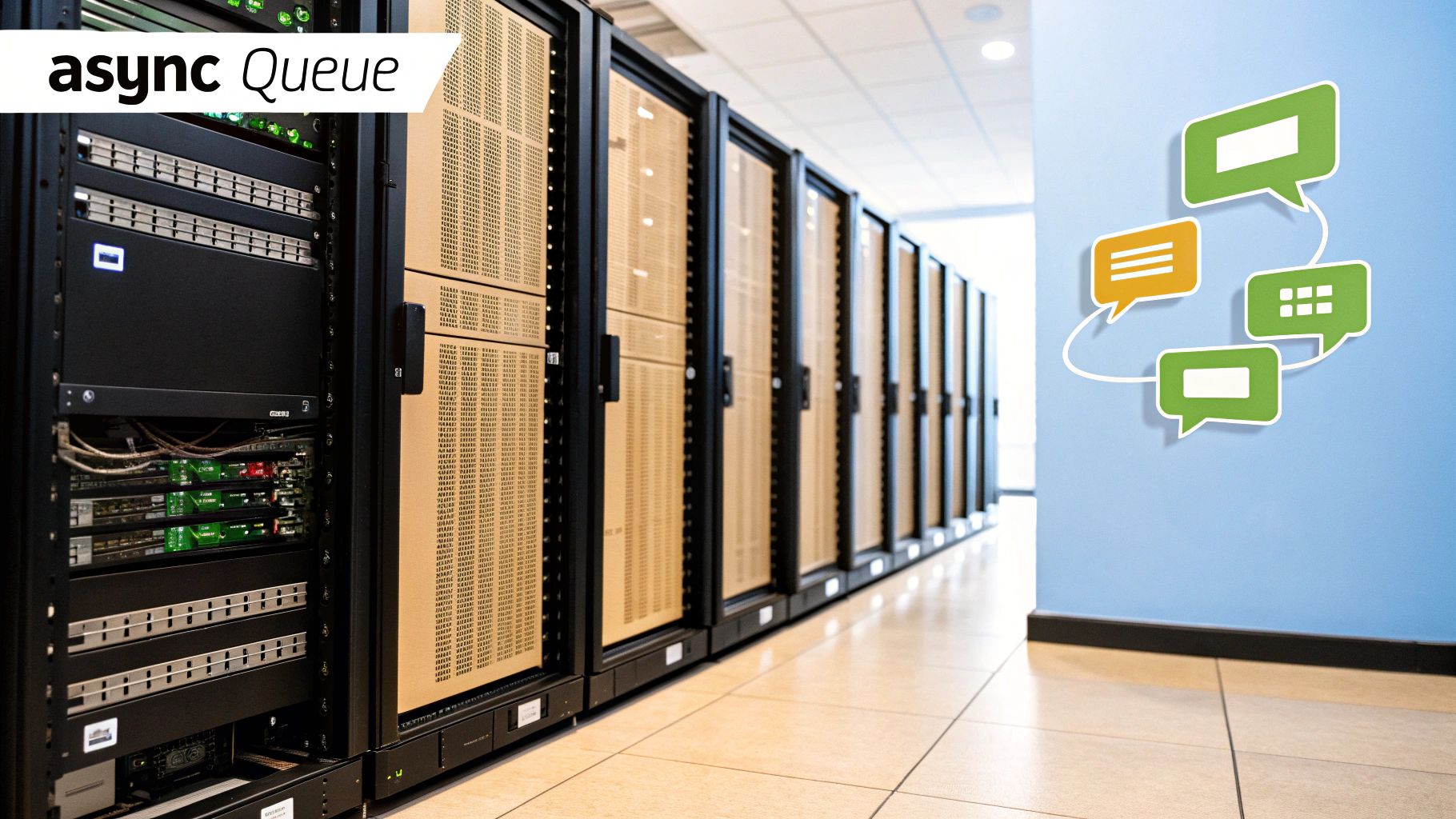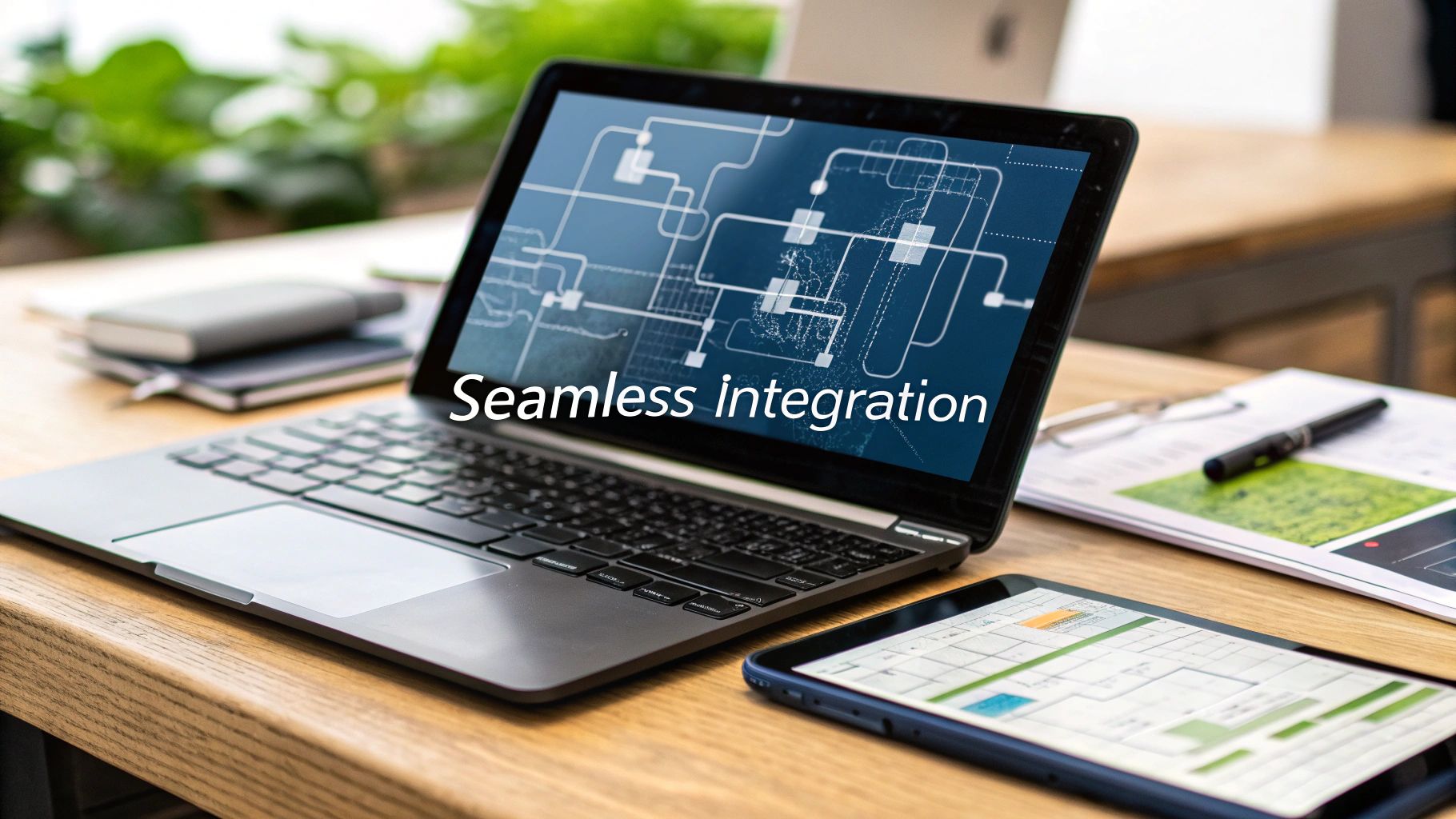In today's interconnected digital ecosystem, the ability to seamlessly link disparate software applications is no longer a technical luxury; it's a core business necessity. Effective integration drives efficiency, unlocks data-driven insights, and creates superior customer experiences. However, poorly planned integrations lead to brittle systems, data silos, and endless maintenance headaches. This guide cuts through the noise to provide a detailed roundup of essential software integration best practices.
We will explore eight critical strategies, moving from foundational API design and robust error handling to advanced monitoring and security protocols. For a deeper understanding of effective software integration, consider exploring these essential Top System Integration Best Practices to complement the hands-on advice provided here.
This article is designed for immediate application, providing actionable steps and clear examples for each practice. The goal is to equip developers, product teams, and founders with the knowledge to build connections that are not only functional but also highly resilient and scalable.
Whether you're building a microservices architecture, connecting to a third-party service, or managing a growing ecosystem of tools, mastering these principles is crucial. By focusing on these proven practices, you can avoid common pitfalls and create a robust, integrated environment that accelerates growth and innovation. This listicle will cover the following key areas:
- Foundational Planning: API-first design and comprehensive error handling.
- Scalable Implementation: Asynchronous processing and ensuring data consistency.
- Robust Operations: Automated testing, security protocols, and version management.
- Long-Term Health: Comprehensive monitoring, logging, and observability.
Let's dive into the specific best practices that will help you build integrations that stand the test of time.
1. API-First Design and Documentation
Adopting an API-first design approach is a cornerstone of modern software integration best practices. This strategy prioritizes the design and documentation of your Application Programming Interfaces (APIs) before writing any implementation code. By treating your API as a primary product, you establish a stable, well-defined contract that governs how different software components, microservices, and third-party systems interact. This proactive method prevents integration challenges that arise from poorly defined or inconsistent interfaces.

This approach ensures that development teams, both internal and external, can work in parallel. While one team builds the backend logic, another can start developing the frontend or a third-party integration using mock servers based on the agreed-upon API contract. This significantly accelerates the development lifecycle and reduces dependencies between teams. Companies like Stripe and Twilio exemplify this, with their comprehensive documentation and consistent API design enabling thousands of developers to integrate their services seamlessly.
Why API-First is Crucial for Integration
An API-first methodology directly addresses common integration pain points. It forces clarity and consensus on data structures, endpoints, and authentication methods early in the process. This clarity minimizes misunderstandings and costly rework down the line. For a practical insight into how APIs are structured and utilized, consider exploring examples such as a Members API, which demonstrates how data and functionality can be exposed for external use.
The resulting documentation serves as a single source of truth, benefiting everyone from developers to product managers and technical writers. It fosters a more robust and scalable architecture, as seen in Netflix's extensive use of an API-first approach to manage its vast ecosystem of over 700 microservices.
Actionable Implementation Tips
To effectively implement an API-first strategy, follow these key steps:
- Standardize with OpenAPI: Use the OpenAPI 3.0 specification to create a machine-readable definition of your API. This standard allows you to automatically generate documentation, client SDKs, and server stubs.
- Implement Semantic Versioning: Manage changes predictably by using semantic versioning (e.g., v1.2.5). This signals the nature of changes to consumers, clearly distinguishing between major breaking changes, new features, and bug fixes.
- Establish a Clear Deprecation Policy: When an API version must be retired, communicate a clear timeline and provide a migration path. This builds trust with your developer community and prevents service disruptions for your users.
By embedding these practices into your workflow, you create a foundation for reliable, scalable, and maintainable software integrations. To dive deeper into this topic, you can learn more about API integration best practices from Refgrow.
2. Comprehensive Error Handling and Retry Logic
A systematic approach to managing failures is fundamental to creating resilient software integrations. This involves implementing structured error handling, intelligent retry mechanisms, and graceful degradation to ensure your system remains stable even when dependencies fail. By anticipating and managing the various failure scenarios common in distributed systems, such as network timeouts, service unavailability, or rate limiting, you can prevent cascading failures and maintain a high-quality user experience.

This practice is essential because integrations, especially with third-party services, are inherently unreliable. A robust error handling strategy ensures that transient faults do not result in permanent failures. For instance, Netflix popularized the circuit breaker pattern with its Hystrix library, which stops sending requests to a failing service for a period, allowing it to recover. Similarly, Amazon SQS uses dead-letter queues to isolate and analyze messages that consistently fail processing, preventing them from blocking the entire queue.
Why Robust Error Handling is Crucial for Integration
Comprehensive error handling is a core tenet of modern software integration best practices because it directly impacts system reliability and availability. Without it, a single failing component can bring down an entire application. By implementing patterns like retries with exponential backoff, you give temporary issues a chance to resolve themselves without overwhelming the downstream service.
This proactive fault tolerance builds trust and ensures business continuity. For example, Shopify’s background job processing system uses exponential backoff for failed tasks, while Uber’s payment system intelligently retries transactions with fallback providers if the primary one fails. These strategies are critical for maintaining service levels and protecting revenue-critical operations from predictable integration hiccups.
Actionable Implementation Tips
To effectively build resilient integrations, implement the following error-handling techniques:
- Use Exponential Backoff with Jitter: When retrying a failed request, don't just wait a fixed amount of time. Implement an exponential backoff strategy (e.g., wait 1s, then 2s, then 4s) and add a small, random amount of time (jitter) to each delay. This prevents the "thundering herd" problem where many clients retry simultaneously.
- Implement Idempotency Keys: Ensure that retried operations are safe to execute multiple times without creating duplicate data or unintended side effects. Pass a unique idempotency key in your API requests so the server can recognize and safely discard duplicate retry attempts.
- Utilize Circuit Breakers: For critical integrations, wrap calls in a circuit breaker. After a configured number of failures, the breaker "trips" and immediately fails subsequent calls without hitting the network, preventing your application from wasting resources on a service that is clearly down.
3. Asynchronous Processing and Message Queues
Implementing an asynchronous architecture with message queues is a powerful software integration best practice for building resilient and scalable systems. This pattern decouples software components by using a central message broker to manage communication. Instead of making direct, synchronous calls that require an immediate response, one system publishes a message (or event) to a queue, and another system consumes and processes that message at its own pace. This approach eliminates tight dependencies, allowing components to operate independently.

This decoupling is essential for fault tolerance. If a consuming service is temporarily unavailable, messages simply accumulate in the queue until the service comes back online, preventing data loss. This model is used extensively by major tech companies. For instance, LinkedIn uses Apache Kafka for its real-time data streaming pipelines, and Airbnb relies on an event-driven architecture to manage complex processes like booking and payment confirmations without blocking user interactions. These examples demonstrate how asynchronous processing enhances system responsiveness and reliability.
Why Asynchronous Processing is Crucial for Integration
An asynchronous approach directly addresses the challenges of integrating distributed systems, especially those with varying workloads and availability. It acts as a buffer, smoothing out traffic spikes and ensuring that a slowdown in one part of the system doesn't cause a cascading failure across others. This makes it ideal for handling background jobs, data pipelines, and event-driven workflows where immediate feedback isn't necessary.
This architecture enables different teams to develop, deploy, and scale their services independently. For a deeper understanding of how these concepts are applied in modern software, explore how various SaaS integration platforms from Refgrow leverage similar principles to connect disparate applications seamlessly. The result is a more robust, elastic, and maintainable integration landscape.
Actionable Implementation Tips
To effectively implement asynchronous processing and message queues, consider these key steps:
- Choose the Right Message Broker: Select a broker like RabbitMQ, Apache Kafka, or Amazon SQS based on your specific needs for message durability, ordering guarantees, and throughput.
- Design for Idempotency: Ensure that processing the same message multiple times produces the same result. This is critical for handling retries and preventing duplicate actions in case of failures.
- Implement Robust Monitoring: Actively monitor queue depths, message processing times, and error rates. Set up alerts to detect backlogs or failures before they impact users.
- Plan for Disaster Recovery: Establish a clear strategy for message replay and system recovery in the event of a catastrophic failure of your message broker or processing services.
4. Automated Testing for Integrations
A robust, automated testing strategy is indispensable for ensuring the reliability and stability of software integrations. This practice moves beyond manual checks to implement a comprehensive suite of automated tests that validate every facet of system interaction. By covering unit, integration, contract, and end-to-end scenarios, you create a safety net that continuously verifies data flow integrity, API contracts, and overall system behavior, making it a critical component of modern software integration best practices.

This approach ensures that as systems evolve, integrations do not silently break. Automated tests, when integrated into CI/CD pipelines, provide immediate feedback to developers, catching regressions and compatibility issues long before they reach production. Industry leaders like Netflix and Atlassian have built their complex ecosystems on a foundation of rigorous automated testing. Netflix, for instance, employs advanced chaos engineering and integration testing to ensure its services remain resilient, while Atlassian uses a dedicated API testing framework to guarantee its Jira and Confluence integrations function flawlessly.
Why Automated Testing is Crucial for Integration
Automated testing directly mitigates the high risk associated with interconnected systems. Manual testing is slow, prone to human error, and simply cannot scale to cover the vast number of interaction points in a microservices architecture or a system with many third-party dependencies. Automation enforces consistency and allows for frequent, repeatable validation of critical integration paths.
The concept of the "testing pyramid," popularized by experts like Martin Fowler, provides a strategic framework for this. It advocates for a large base of fast unit tests, a smaller layer of integration tests, and a minimal number of slow, comprehensive end-to-end tests. This structure optimizes for both speed and coverage.
Actionable Implementation Tips
To effectively implement automated testing for your integrations, focus on these key strategies:
- Implement Contract Testing: Use tools like Pact, pioneered by ThoughtWorks, to verify that services honor their API agreements. Consumer-driven contract tests ensure that a provider service doesn't introduce a breaking change that impacts its consumer services.
- Establish Isolated Test Environments: Create dedicated testing environments that closely mirror your production setup. This isolation prevents tests from interfering with each other or impacting live data, providing a reliable space for validation.
- Use Test Data Management: Develop a strategy for managing test data to ensure your tests are consistent, repeatable, and cover a wide range of scenarios. This includes generating realistic but anonymized data sets.
- Include Negative and Edge-Case Testing: Go beyond "happy path" scenarios. Write tests that simulate invalid inputs, network failures, and other error conditions to ensure your integration handles failures gracefully.
5. Idempotency and Data Consistency
Ensuring idempotency and data consistency is a critical software integration best practice, especially in distributed systems where network failures and retries are inevitable. Idempotency is the principle that an operation, if performed multiple times, will have the same effect as if it were performed only once. This prevents duplicate requests from corrupting data or triggering unintended actions, ensuring system reliability and predictable behavior.
When an API client sends a request but doesn't receive a response due to a timeout, it doesn't know if the request was processed. Without idempotency, resending the request could lead to duplicate charges, orders, or data entries. Payment processors like Stripe master this concept by allowing developers to pass a unique Idempotency-Key in the request header. If Stripe receives a request with a key it has already processed, it safely returns the original response without executing the transaction again.
Why Idempotency is Crucial for Integration
Idempotency directly addresses the unreliability of networks. By designing operations to be safely repeatable, you build resilience into your integrations. This is fundamental for any system handling critical data, such as financial transactions, inventory management, or order processing. Amazon's order processing system, for example, is built to handle repeated submission attempts without creating duplicate orders, safeguarding both customer experience and business operations.
This practice also simplifies error recovery for client applications. Instead of building complex logic to determine if a request succeeded, clients can simply retry with the same idempotency key until they receive a successful response. This leads to a more robust and fault-tolerant architecture, which is a cornerstone of modern distributed systems as highlighted in research from pioneers like Pat Helland.
Actionable Implementation Tips
To effectively implement idempotency and maintain data consistency, follow these key steps:
- Generate Unique Idempotency Keys: Have the client generate a unique key (like a UUID) for each distinct operation. The server then stores the result of the operation against this key for a certain period, allowing it to intercept and respond to duplicate requests.
- Design Naturally Idempotent APIs: Where possible, design API operations to be inherently idempotent. For example, a
PUT /users/123request to update a user's profile is naturally idempotent, as repeated calls will result in the same final state. - Implement Proper Database Constraints: Use unique constraints in your database to prevent duplicate record creation at the data layer. This acts as a final line of defense against inconsistencies.
- Use Distributed Locking for Critical Sections: For operations that are not naturally idempotent and involve multiple steps, a distributed locking mechanism can ensure that only one process can execute the critical section of code at a time, preventing race conditions.
6. Security and Authentication Best Practices
Prioritizing security and authentication is a non-negotiable software integration best practice. This involves a comprehensive strategy to protect data and system resources by controlling who can access what. Proper authentication verifies the identity of users or systems, while authorization defines their access permissions. This dual-layered approach is fundamental to safeguarding sensitive information as it flows between different applications, preventing unauthorized access and potential data breaches.
Implementing robust security measures ensures that integrations do not become weak points in your system's architecture. It builds trust with users and partners who rely on your software to handle their data securely. For instance, Google's use of OAuth 2.0 for API access allows third-party applications to use its services on a user's behalf without ever exposing the user's password. Similarly, AWS Identity and Access Management (IAM) provides granular control over which services can interact, minimizing the attack surface.
Why Security is Crucial for Integration
In an interconnected digital ecosystem, a single insecure integration can compromise the entire system. A strong security posture addresses this risk by creating multiple defense layers, from encrypting data in transit and at rest to implementing strict access controls. This proactive stance is essential for maintaining data integrity, achieving regulatory compliance (like GDPR or HIPAA), and protecting your organization's reputation.
Adopting modern authentication standards like OAuth 2.0 and OpenID Connect, championed by organizations like the OAuth Working Group and the OWASP Foundation, provides a standardized, secure framework. Salesforce's JWT Bearer Token flow, for example, enables secure server-to-server authentication without direct user interaction, a common requirement in enterprise integrations.
Actionable Implementation Tips
To effectively secure your software integrations, embed these key practices into your development lifecycle:
- Implement Least Privilege Access: Grant systems and users only the minimum permissions necessary to perform their functions. GitHub's fine-grained personal access tokens are a prime example, allowing developers to scope token permissions to specific repositories and actions.
- Use Short-Lived Tokens: Employ tokens with short expiration times and use refresh mechanisms to obtain new ones. This practice, central to OAuth 2.0, limits the window of opportunity for an attacker if a token is compromised.
- Encrypt Data and Validate Inputs: Encrypt all sensitive data both in transit (using TLS) and at rest. Additionally, rigorously validate and sanitize all inputs to prevent common vulnerabilities like SQL injection and Cross-Site Scripting (XSS).
- Conduct Regular Security Audits: Regularly perform security audits, vulnerability scanning, and penetration testing on your integration points to identify and remediate potential weaknesses before they can be exploited.
By making security a core component of your integration strategy, you create a resilient and trustworthy system. To explore this area further, you can learn more about authentication best practices from Refgrow.
7. Monitoring, Logging, and Observability
Establishing robust monitoring, logging, and observability is a critical software integration best practice for maintaining system health and performance. This involves systematically collecting and analyzing data to gain deep visibility into how your integrations are behaving in real time. By moving beyond simple uptime checks, this practice allows you to proactively detect issues, accelerate troubleshooting, and make data-driven decisions to optimize your connected systems. It transforms your approach from reactive problem-solving to proactive performance management.
This comprehensive visibility is the bedrock of reliable integrations, especially in complex, distributed architectures. It enables you to understand the complete journey of a request as it travels through various services and third-party APIs. Companies renowned for their operational excellence, like Netflix and Uber, have pioneered observability at scale. Netflix uses distributed tracing to debug its vast microservices network, while Uber leverages tools like Jaeger to ensure its ride-sharing platform remains resilient and performant, even under extreme load.
Why Observability is Crucial for Integration
Effective observability directly addresses the black-box nature of many software integrations. When an integration fails, the challenge is often pinpointing where and why it failed. Comprehensive logging, metrics, and tracing provide the necessary context to diagnose problems quickly, reducing mean time to resolution (MTTR). This is crucial for maintaining user trust and meeting service-level agreements (SLAs).
A well-observed system allows you to correlate technical events with business outcomes. For instance, you can link a spike in API latency to a drop in user conversions, providing a clear business case for performance improvements. This level of insight is essential for any modern application, as demonstrated by the widespread adoption of platforms like Datadog and New Relic, which help thousands of companies turn raw operational data into actionable intelligence.
Actionable Implementation Tips
To effectively implement monitoring, logging, and observability, follow these key steps:
- Implement Correlation IDs: Assign a unique correlation ID to every request at the edge of your system. Pass this ID through all subsequent service calls and logs, allowing you to trace a single transaction's entire lifecycle across distributed systems.
- Use Structured Logging: Adopt a structured logging format like JSON. This makes logs machine-readable, dramatically improving the efficiency of searching, filtering, and analyzing log data in platforms like Splunk or an ELK Stack (Elasticsearch, Logstash, Kibana).
- Set Up Meaningful Alerts: Configure alerts based on business-impact metrics (e.g., failed payment transactions, user sign-up errors) and service-level indicators (SLIs), not just raw technical metrics like CPU usage. This ensures your team focuses on issues that truly affect users.
- Create Operational Runbooks: Document common integration failure scenarios and the step-by-step procedures to resolve them. These runbooks empower your on-call team to respond to incidents quickly and consistently, even if they are unfamiliar with a specific integration.
8. Version Management and Backward Compatibility
A strategic approach to version management is fundamental to long-term software integration best practices, ensuring that systems can evolve without breaking existing connections. This involves carefully managing changes to integration points like APIs while maintaining backward compatibility for older implementations. By adopting robust versioning strategies and clear deprecation policies, you allow consumers of your software to upgrade on their own schedule, preventing forced, disruptive updates and fostering trust.
This practice is essential for creating a stable and predictable integration ecosystem. When an interface changes, a clear versioning system communicates the nature and severity of that change. For instance, Stripe has masterfully implemented this with its date-based API versioning. Developers can lock their integration to a specific API version, guaranteeing that future backward-incompatible changes won't affect their live systems until they are ready to migrate. This stability is a key reason for Stripe's widespread adoption.
Why Versioning is Crucial for Integration
Without deliberate version management, even minor updates can cause major disruptions for integrated partners. A seemingly small change in a data field or endpoint behavior can break dependent applications, leading to service outages and damaging relationships. A formal versioning strategy acts as a contract, providing clarity and predictability for everyone involved.
This disciplined approach is critical in complex ecosystems. Consider Salesforce, which supports dozens of API versions simultaneously, allowing a vast network of enterprise applications to function without interruption while Salesforce continues to innovate. This commitment to backward compatibility ensures the health and longevity of its entire platform, demonstrating how vital versioning is for scalable software integration.
Actionable Implementation Tips
To effectively implement version management and maintain backward compatibility, follow these key steps:
- Follow Semantic Versioning: Adhere to the Major.Minor.Patch (e.g., 2.1.0) standard for your APIs and components. This universally understood format clearly signals breaking changes (Major), new non-breaking features (Minor), and backward-compatible bug fixes (Patch).
- Provide Clear Migration Guides: When introducing a breaking change, publish comprehensive documentation and, if possible, automated tooling to help developers migrate. The extensive transition period and guidance provided during Twitter's API v1.1 to v2.0 migration serves as a strong example.
- Maintain a Detailed Changelog: Keep a public, easy-to-read changelog that documents every change, bug fix, and new feature. This transparency is crucial for developers planning their updates.
- Establish a Deprecation Policy: Give partners ample notice before retiring an old version or feature. A clear timeline, often 6 to 12 months, allows them to plan and allocate resources for the necessary migration.
Integration Best Practices Comparison
| Item | Implementation Complexity 🔄 | Resource Requirements ⚡ | Expected Outcomes 📊 | Ideal Use Cases 💡 | Key Advantages ⭐ |
|---|---|---|---|---|---|
| API-First Design and Documentation | Medium: upfront design and documentation | Moderate: tooling for specs and mock servers | Consistent APIs, easier integration, improved maintainability | Large, multi-team projects; APIs as contracts | Parallel development, reduced debugging, better testing |
| Comprehensive Error Handling and Retry Logic | High: complex code for retries and fallback | High: monitoring and tuning needed | Increased reliability and uptime, failure resilience | Distributed systems prone to transient failures | Prevents cascading failures, reduces manual fixes |
| Asynchronous Processing and Message Queues | High: architectural complexity and infrastructure | High: message brokers and monitoring systems | Improved scalability and fault tolerance, decoupled components | High-throughput, scalable systems needing async processing | Better resource utilization, natural fault isolation |
| Automated Testing for Integrations | Medium-High: test infrastructure setup | Moderate-High: test environments and tools | Early issue detection, reduced regressions, faster releases | Systems with frequent changes and complex integrations | Confidence in integration, supports CI/CD |
| Idempotency and Data Consistency | High: complex logic and data handling | Moderate: storage and additional tracking | Safe retries, data integrity, consistent distributed state | Payment, order processing, and critical data operations | Prevents data corruption, simplifies error recovery |
| Security and Authentication Best Practices | Medium-High: complex security mechanisms | Moderate: ongoing updates and monitoring | Protected data, regulatory compliance, secure integrations | Systems handling sensitive data or external access | Trust building, reduces security risks |
| Monitoring, Logging, and Observability | Medium: setup of monitoring and logging tools | Moderate-High: infrastructure and data management | Proactive issue detection, faster troubleshooting | Large-scale distributed systems requiring visibility | Reduces MTTR, helps optimization and capacity planning |
| Version Management and Backward Compatibility | Medium: planning and coordination required | Moderate: documentation and tooling | Smooth upgrades, no breaking changes, customer satisfaction | APIs with multiple clients and frequent changes | Maintains compatibility, enables gradual migration |
From Theory to Practice: Building Your Integration Blueprint
Navigating the complex landscape of modern software development requires more than just innovative features; it demands a robust, interconnected ecosystem. Throughout this guide, we've journeyed through the core tenets that transform disjointed applications into a seamless, unified platform. These aren't just abstract theories; they are the fundamental software integration best practices that distinguish resilient, scalable systems from fragile, brittle ones. Moving forward, the goal is to shift from understanding these concepts to actively implementing them as a core part of your development culture.
The eight pillars we've discussed, from API-first design to disciplined version management, form a comprehensive blueprint for success. They are not a checklist to be completed once but a continuous discipline. Embracing an API-first approach, for instance, fundamentally reorients your team to think of services as products for other developers, fostering clarity and reusability from day one. Similarly, building in comprehensive error handling and asynchronous processing isn't just about preventing system crashes; it's about creating a user experience that remains smooth and reliable even when dependencies fail.
Key Takeaways for Your Integration Strategy
As you embark on your next integration project, keep these critical takeaways at the forefront of your planning and execution phases:
- Resilience is Designed, Not Accidental: Systems fail. The difference between a minor hiccup and a catastrophic outage lies in proactive design. Implementing idempotent APIs, intelligent retry logic, and asynchronous message queues ensures your architecture can withstand and gracefully recover from inevitable network glitches and service disruptions.
- Trust is Built on Security and Consistency: Your integrations are a direct extension of your brand's promise. Rigorous security protocols, including robust authentication and authorization, are non-negotiable. This, combined with a commitment to data consistency through idempotency, builds a foundation of trust with both your users and your integration partners.
- Visibility is Your Greatest Asset: You cannot manage what you cannot see. A sophisticated observability stack, encompassing detailed logging, real-time monitoring, and actionable alerts, is your command center. It provides the insight needed to diagnose issues before they escalate, optimize performance, and understand how your integrated systems behave in the real world.
Your Actionable Next Steps
Mastering these software integration best practices is a journey, not a destination. Begin by selecting one or two key areas to focus on for your next project. Perhaps you can start by formalizing your API documentation using the OpenAPI specification or by implementing a message queue like RabbitMQ or AWS SQS to decouple a critical workflow.
Key Insight: The most significant improvements often come from incremental, focused changes. Instead of attempting a complete overhaul, target the most painful or fragile integration point in your current system and apply these principles to fortify it. This iterative approach builds momentum and demonstrates tangible value quickly.
By consistently applying these principles, you do more than just connect software. You build a strategic asset: a flexible, secure, and scalable digital infrastructure that can adapt to changing market demands and new technological opportunities. This disciplined approach reduces technical debt, accelerates development cycles, and ultimately empowers your team to focus on delivering core business value instead of constantly fighting integration fires. You are not just building connections; you are building the future-proof foundation of your business.
Ready to see these principles in action without building everything from scratch? Refgrow provides a fully embeddable, API-driven affiliate and referral program solution that exemplifies best-in-class integration. We handle the complexity of tracking, attribution, and payouts, allowing you to launch a powerful, native growth engine in days, not months. Explore how Refgrow can accelerate your product-led growth with seamless integration.

